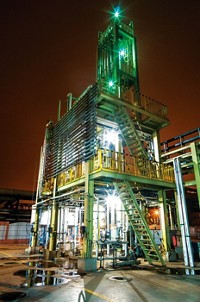Advertisement
Grab your lab coat. Let's get started
Welcome!
Welcome!
Create an account below to get 6 C&EN articles per month, receive newsletters and more - all free.
It seems this is your first time logging in online. Please enter the following information to continue.
As an ACS member you automatically get access to this site. All we need is few more details to create your reading experience.
Not you? Sign in with a different account.
Not you? Sign in with a different account.
ERROR 1
ERROR 1
ERROR 2
ERROR 2
ERROR 2
ERROR 2
ERROR 2
Password and Confirm password must match.
If you have an ACS member number, please enter it here so we can link this account to your membership. (optional)
ERROR 2
ACS values your privacy. By submitting your information, you are gaining access to C&EN and subscribing to our weekly newsletter. We use the information you provide to make your reading experience better, and we will never sell your data to third party members.
Environment
Green Chemistry Is A Guide For Industrial Biotechnology
AWARD-WINNING PROCESSES
April 3, 2006
| A version of this story appeared in
Volume 84, Issue 14
Most of the developments in industrial biotechnology have their foundations in the principles of green chemistry, which emphasize developing economically viable products and processes that require fewer reagents, less solvent, and less energy than conventional processes, while being safer, generating less waste, and having a lower environmental impact.
The benefits of industrial biotechnology are observable in data collected by the Environmental Protection Agency to measure the impact of the technologies developed by recipients of the annual Presidential Green Chemistry Challenge Awards, which EPA administers. The award-winning processes are preventing an average of 140 million lb of hazardous substances from being produced each year, saving more than 55 million gal of process water per year, and preventing 57 million lb of carbon dioxide emissions per year. In total, green chemistry technologies are preventing more than 3 billion lb of hazardous materials or waste per year, according to EPA.
A few examples of recent award winners follow:
Metabolix Inc., Cambridge, Mass., has developed a fermentation process to produce biodegradable polyhydroxyalkanoate (PHA) "natural plastics" from renewable feedstocks. Some bacteria naturally synthesize PHAs for energy storage, much as animals produce fat. Metabolix has taken advantage of this biopolymerization process by incorporating a series of genes from various PHA-producing bacteria into a strain of Escherichia coli. The genes in turn express enzymes that can convert sugars or oil into polymers via a multistep process within the bacterial cells.
The key markets for PHA plastics include food packaging; disposable and single-use items, such as dinnerware and coated-paper hot-beverage cups; and agricultural and soil-stabilizing applications requiring biodegradation. Metabolix has been producing small amounts of PHAs through contract firms, but it has now teamed up with Archer Daniels Midland (ADM) to begin large-scale production of the polymers by mid-2008. Metabolix will join Cargill (NatureWorks polylactic acid) and DuPont (Sorona polypropylene terephthalate)—both former Green Chemistry Award winners—as commercial producers of biomass-based polymers.
Metabolix also is developing genetically engineered plants, such as switchgrass, a native prairie grass, that directly produce PHAs in plant cells. The PHAs could be processed as polymers or depolymerized to form hydroxy acids for use as chemical feedstocks, and the residual plant material can be burned for energy or the cellulose converted to liquid fuels.
Jeneil Biosurfactant Co., Saukville, Wis., has developed a series of rhamnolipid biosurfactants that can be substituted for or used in conjunction with synthetic surfactants used in the petroleum industry, agriculture, personal care products, and other applications. Rhamnolipids are natural glycolipids produced by strains of Pseudomonas aeruginosa bacteria in soil and on plants. The compounds contain a sugar group and a long, branched fatty acid tail that imbues them with high surface-active properties and low toxicity. Rhamnolipid biosurfactants are alternatives to common surfactants such as nonylphenol ethoxylate, which has come under scrutiny for its potential environmental toxicity.
ADM and Novozymes put their talents together to develop NovaLipids, a brand of zero- and reduced-trans-fat vegetable oils that are being used to make margarine, processed baked goods, and other foods. Food processors traditionally have used partially hydrogenated vegetable oils to control the texture and taste of foods. But the chemical treatment to make those oils leads to some isomerization and formation of unwanted trans fats.
One way to avoid the problem is to use fully hydrogenated oil and "interesterify" it with unhydrogenated oil. Interesterification cleaves and randomly exchanges the positions of the three fatty acid chains of the various triglycerides in oils. ADM uses a lipase enzyme immobilized on porous silica particles developed by Novozymes to catalyze interesterification, rather than using sodium methoxide. The company is now producing millions of pounds of lipase-interesterified oils by the greener process, saving capital and operating costs.
Buckman Laboratories International, Memphis, has developed the Optimyze enzyme technology using an enzyme produced by Novozymes to improve processing of recycled paper. Optimyze is an esterase liquid formulation added during the paper-recycling process to help degrade and remove sticky chemical buildup that arises from adhesives, plastics, and inks. These "stickies" foul processing equipment and lead to lower quality products. The enzyme formulation is inherently safer to transport and handle than organic solvents and surfactants currently used for most paper recycling, and it provides economic benefits by reducing chemical usage and boosting paper production.
MORE ON THIS STORY
EMPLOYMENT - INDUSTRIAL BIOTECH
Industrial Biotech Gains Momentum
Growth of commercial enzyme-mediated processes points to the future of the chemical industry
End Use
The Three Biotechnologies
Award-WIinning Processes
Green Chemistry Is A Guide For Industrial Biotechnology





Join the conversation
Contact the reporter
Submit a Letter to the Editor for publication
Engage with us on Twitter